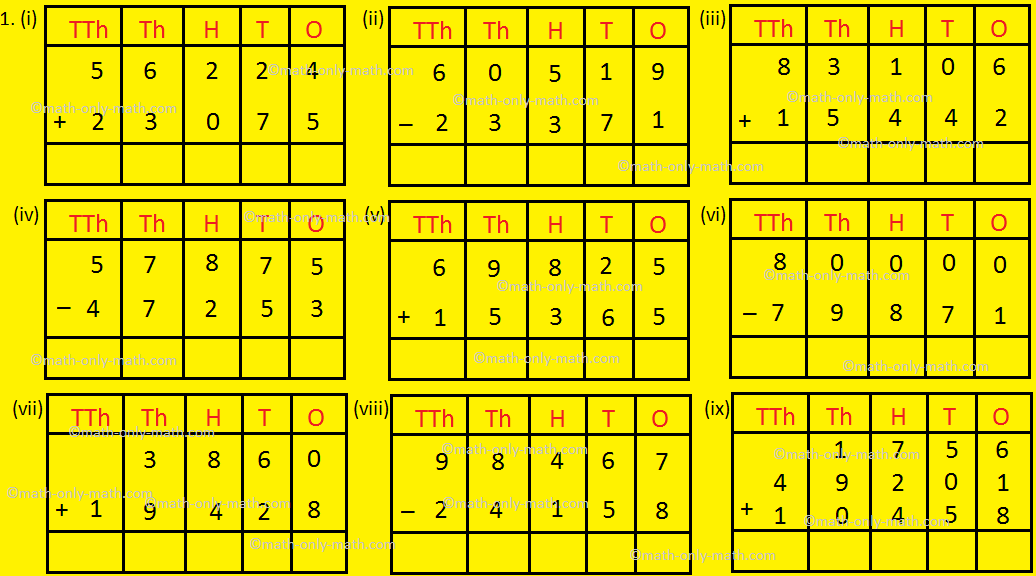Subscribe to our ▶️ YouTube channel 🔴 for the latest videos, updates, and tips.
Worksheet on Operations On Whole Numbers
In worksheet on operations on whole numbers students can practice the questions on four basic operations with whole numbers.
We have already learnt the four operations and now we will use the procedure for doing the basic operations on large numbers up to five-digits. Let us solve the following questions to quickly get the idea what we have learnt.
I. Find the product of the given number:
|
(i) 2287 × 17 (ii) 3846 × 256 (iii) 4592 × 35 |
(iv) 7005 × 63 (v) 9871 × 26 (vi) 1029 × 107 |
II. Solve the following:
III. Divide the following and find the quotient and remainder:
(i) 3872 ÷ 26
(ii) 7739 ÷ 112
(iii) 5310 ÷ 15
(iv) 3258 ÷ 140
(v) 4028 ÷ 41
(vi) 3072 ÷ 122
IV. Using the digits 2, 9, 3, 6 and 0 form the largest and the smallest possible 5-digit numbers. Find the difference between the two numbers formed.
V. Given below is the number of people who came to watch the football matches at XYZ stadium in a week. Observe the given data and answer the following questions.
|
Days |
Numbers of Spectators |
|
Monday |
21,587 |
|
Tuesday |
15,721 |
|
Wednesday |
16,040 |
|
Thursday |
13,674 |
|
Friday |
22,876 |
|
Saturday |
26,330 |
|
Sunday |
25,889 |
(i) On which day did the minimum numbers of spectators see
the match?
(ii) If the price of one ticket to the stadium is 50 in the local currency, how much money was collected on Tuesday?
(iii) What was the total number of spectators who came to XYZ stadium during the week?
(iv) How many more spectators were there on Saturday than Wednesday?
Answers for the Worksheet on Operations On Whole Numbers are given below to check the exact answers of the questions.
Answers:
I. (i) 38879
(ii) 984576
(iii) 160720
(iv) 441315
(v) 256646
(vi) 110103
II. (i) 79299
(ii) 37148
(iii) 98548
(iv) 10622
(v) 85190
(vi) 129
(vii) 23288
(viii) 74309
(ix) 61415
III. (i) Quotient = 148, remainder = 24
(ii) Quotient = 354, remainder = 0
(iii) Quotient = 98, remainder = 10
(iv) Quotient = 69, remainder = 11
(v) Quotient = 23, remainder = 38
(vi) Quotient = 25, remainder = 22
IV. 96320; 20369; 75951
V. (i) Thursday
(ii) 786050
(iii) 142117
(iv) 10290
5th Grade Math Problems
From Worksheet on Operations On Whole Numbers to HOME PAGE
Didn't find what you were looking for? Or want to know more information about Math Only Math. Use this Google Search to find what you need.



New! Comments
Have your say about what you just read! Leave me a comment in the box below. Ask a Question or Answer a Question.